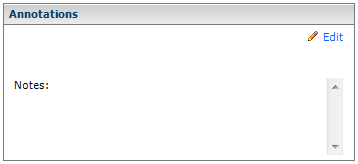Yesterday, a few of my fellow co-workers approached me with a problem. They asked if I would be interested in figuring out a way to update the Notes: field within the annotations section on the summary tab of each VM we have in our server environment.
For those of you unfamiliar with VM Annotations, its a simple box that looks like this:
Pretty interesting, right?
Enter PowerCLI, a plugin for PowerShell that enables scripting for vCenter. In some brief searching online, I found many forum posts, blog posts, and VMware KB topics highlighting some advanced scripting features within vCenter that are offered through PowerCLI (I hope to cover PowerCLI in more detail in future posts, for now we’ll get back to this one). However, all I wanted to do was modify some annotations.
I began to narrow my searches and came across a few articles, including this site:
http://www.cassese.net/?p=34I found the information to be very useful, but it only covered scripting entries for the custom attributes. Nothing about the
Notes: field.
I kept searching.. and searching.. and after an hour and a half, I had two sources that shared a common characteristic.
$vmcSpec.config = New-Object VMware.Vim.VirtualMachineConfigSpec
$vmcSpec.config.annotation = “whatever textyou want in the notes field”
There it was! All I had to do was create a new VirtualMachineConfigSpec object. Now I had to figure out how to do that.
This is the final script I came up with, albeit I hope to modify it somewhat more (csv file input for starters), it’s functional nonetheless.
# Input array, includes all VM names within vCenter you wish to edit.
$vms = "vm1","vm2";
# Loop through all VMs within vCenter
ForEach ($vmname in $vms) {
# Create variables for the current VM and its "Contact" and "Description" which are custom attribute fields.
$vm = Get-VM -Name $vmname;
$contact = $vm | Get-Annotation -CustomAttribute Contact;
$description = $vm | Get-Annotation -CustomAttribute Description;
$vm | %{Get-View $_.ID} | % {$spec = New-Object VMware.Vim.VirtualMachineConfigSpec;
# Edit the annotation notes field
$spec.Annotation = ""+$contact.name+":`t"+$contact.value+"`n`n"+$description.name+": "+$description.value;
# Re-configure the current VM to apply changes
Get-View($_.ReconfigVM_Task($spec))}
}
Quick Update: I posted my script on the VMware PowerCLI forums,
http://communities.vmware.com/message/1787432#1787432, and LucD was kind enough to suggest using
Set-VM -Description as a simpler way of editing the
Notes: field. I did and it turns out this method was much easier. The new code is below.
Updated Code:
# Input array, includes all VM names within vCenter you wish to edit.
$vms = "vm1","vm2";
# Loop through all VMs within vCenter
ForEach ($vmname in $vms)
{
# Create variables for the current VM and its "Contact" and "Description" which are custom attribute fields.
# Also create a string $note to use with Set-VM -Description
$vm = Get-VM -Name $vmname;
$contact = $vm | Get-Annotation -CustomAttribute User;
$description = $vm | Get-Annotation -CustomAttribute Description;
$note = $contact.name+":`t"+$contact.value+"`n`n"+$description.name+":`t"+$description.value;
Set-VM -VM $vm -Description $note -Confirm:$false;
}
